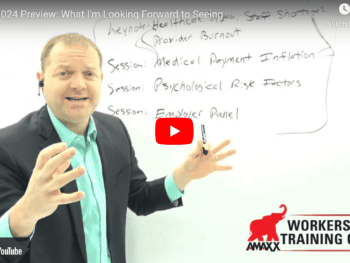WC National Conversation Series:
- Part #1 WC National Conversation: Political Influence, History, And Current Major WC Issues
- Part #2: WC National Conversation: Imperative Issues and Friction Points
- Part #3: WC National Conversation: Regulations, Unintended Consequences, & Standards
Click Link to Access Free PDF Download
“The 5Cs to Taking a Bulletproof Injured Worker Recorded Statement”
Hello, Michael Stack here, principal of Amaxx, founder of COMPClub, and co-author of Your Ultimate Guide To Mastering Worker’s Comp Cost. This is my second part in a three-part series detailing the discussions and events at the Worker’s Compensation Summit that was hosted in Dallas on May 10 and 11, 2016. That event was hosted by Bob Wilson from workerscompensation.com, and Deputy Chief Judge, David Langham.
Discussion on Fairness & Adequacy of Work Comp System
Thirty-nine stake holders came together, in order to talk about the current status and future of our industry, because there have been questions about the fairness and adequacy of worker’s compensation, and if that’s the right solution to handling work place injuries. These thirty-nine stake holders represented various different interests including employees, employers, injured workers, claimant’s attorneys, defense attorneys, medical providers. A whole host of experience, knowledge and perspective to have this important discussion.
In the first part of this three-part series, I went over those pre-summit documents. If you’ve yet to view that video, I highly recommend that you do. There is information in there that you have not seen before. A study you haven’t seen, or a letter you haven’t seen. I guarantee you are going to pull out an important piece of information that you didn’t previously know. So, if you haven’t seen that video, I highly recommend checking it out.
Imperative Issues & Friction Points
In this video then, I’m going to be talking about the bulk of our discussion over the course of those two days. This discussion that we had was in regard to the imperative issues and some of the friction points that are causing the challenges in the Work Comp System. The discussion is not about whining or complaining about where we are. It’s about identifying, from a very pragmatic stand point, what these problems are and listing them out, so that then we can now start talking about the solution, and talking about a positive and productive outcome for this national conversation.
In my last video, I will be talking about the regulatory points and some paradoxical incentive point that really exists, and now where we take this conversation from here. As I mentioned in this video, I’m going to be talking about a 12 to 14 hour discussion that was had, and I want to preface this video by saying, it’s going to be really impossible for me to do that discussion 100% justice. There was so much perspective and so much information that was shared over that 12-14 hours. I’m going to do my best to give you a summary of that information, really in a matter of a few minutes. I’m going to do my best to do that, but just preface that by saying, it’s going to be very difficult to do that complete discussion justice.
That being said, the main categories of imperative issues that were identified will really fall under 6 umbrellas. The first is different incentives that occur. The second is the complexity of the system. The third is the perceptions and human emotion. Fourth being the fraud and malingering, and those different elements that exist in this system. Fifth is fairness and adequacy, and then finally, the alternatives to Work Comp. Some of those different issues that are going on.
Incentives
Churn
Let’s talk first about incentives, and some of those imperative issues that exist under that umbrella. When you talk about incentives, you look at some of the financial incentives being the main driver. Of course, when you talk about financial, you need to realize that the longer a claim goes on, the more a claim goes south, the more money is generated. The more vendors get involved. The more medical providers get involved. The more treatments are occurring. The more people are involved in this claim, the more money that generates. That’s call the churn. A lot of money is made off of the churn. There’s a lot of lobbyists and efforts, in order to preserve that, because of the financial incentive that exists. The more involved the claim becomes, the more money that generates. Major point, not to be discounted.
State Competition
Second point, from an incentive standpoint, is the state competition. The fact that we have fifty different states, and fifty different state laws, lends Worker’s Compensation to being a tool to keep employers in your particular state if you’re a regulator. Or to attract employers to your state, if they are not currently there. So, you think about this from a national perspective. States have significant, financial benefits and job creation. Benefits to the economy, higher taxes, etc. When a large employer relocates to their state. When another state loses that large employer, it’s a significantly negative impact on that state’s financial economy. The competition between the states an the use of worker’s compensation as a too to attract employers to either stay in their state or not, or attract them to move to a new state, is a significant financial incentive. Again, not to be discounted, these financial different incentives that exist.
Complexity
Regulatory Complexity
Okay. Next point then is complexity. A lot of discussion on this point. A lot of discussion surrounding complexity and the various, different influences that occur with this. Let’s talk first about regulatory complexity, and get some scope on this. It was very interesting when you’re starting to hear national employers, large employers are hearing national carriers and VPs discuss this point, because it starts to really give you that perspective of what this looks like. Imagine that you’re a large employer or a large carrier CPA. You have fifty different state laws.
The point was made that there are three hundred forms that are updated every quarter nationally. Three hundred forms updated every quarter nationally. If you’re a claims handler or a self insured, self administered employer, trying to keep pace with those regulatory changes is a huge financial burden in order to do that. Second piece then is when you’re talking about these regulations and trying to get states to agree on certain points. We talked many times about how it is impossible to get states to agree to even what the poster looks like, what the design is and what goes on that poster. It’s been attempted on a few different occasions and they’ve not been able to agree. So, if the states can’t agree on what a poster looks like, how are they going to agree on the more complex state law issues? Huge regulatory burden.
When you now think about what that means, as far as finances, staff and additional resources that need to be applied, you start to see. Okay, now we need to generate some more money and some of those financial incentives are kicked in because of that regulatory burden and some of those different elements that are in place.
Lawyers
Next point there is lawyers in the system. Different perspectives, of course, that come from looking at lawyers. A lot of times they’re viewed as a benefit. A lot of times they’re viewed as a negative, depending on who you are and the attorney that you’re working with and the perspective that you’re bringing to the table. We know from data, when lawyers are involved, the claims are more expensive. When lawyers are involved, the claims become more expensive. That’s not to say that they’re not needed in the system, but a lot of times, it’s driving up costs, driving up legal briefs, driving up more administration, more following these regulatory issues, and not necessarily creating a better outcome for those injured workers. So, lawyers in the system certainly add to the complexity, depending on the perspective that you’re looking at. No doubt adding to the complexity, the lawyers in the system.
Roles & Delineation
Next, the different roles of different individuals and the delineation of those roles. This was discussed, primarily, in the light of adjusters. Adjusters are often asked to be attorneys. They’re often asked to be doctors. They’re certainly asked to be claims handlers, and they’re put a huge case load. Sometimes in excess of three hundred case files in order to try and now manage this very complex system that we’re discussing, with a huge case load, and a huge amount of work, and asked to make these decisions that they may or may not be qualified to make. Really, it’s putting that complexity on top of that individual.
Next under this role is really the vendors. The amount of vendors that are involved in our system because of this complexity creates little cottage industries that pop up in order to handle that complexity within our industry. It was mentioned that if you walk through a national convention, the sea and the maze of vendors. If you had no idea what you were looking at, then you had no idea what you were looking at, because it’s hard to really understand what that is. Now, you talk about those roles and the number of the different vendors and the adjusters and all the different people that are contacting the injured worker. If you’re an injured worker, you had no idea about the Work Comp industry before getting injured. You really didn’t care much about it. Now you’ve got maybe one, two, five, seven different people that are contacting you and you’re trying to make sense of the whole thing. No wonder you’re contacting an attorney, because you want to make sure that your needs are protected.
So, that makes a lot of sense and really that overwhelming need of different people that are involved in this industry trying to make it extraordinarily complex. Final piece that is really staffing and training. So, when you talk about the role and the burden that’s put on the adjuster, and again, it goes back to, certainly going back to this financial incentive, carriers are in the business of making money. They need to make a profit. And so, what often times people are asked to do more with less and that is certainly one of the functions that come into play when you’re talking about those roles that the adjusters are asked to play. It goes down to this staffing and training. There’s been a lot of studies that have come out in regards to the amount of people who are going to be retiring from our industry and trying to attract the next generation of talent, to now fill in those gaps. How do we get that next generation trained to understand all of this complexity, make these decisions for these proper outcomes? Certainly an issue that falls under the imperative issues umbrella.
Perception and Human Elements
Work Comp has a Bad Reputation
Next piece then. So, that talks about the complexity. The next piece that we’re going to be talking about is this perception and human elements. So, the perception and human elements. Often times when we’re talking about state laws, we’re talking about finances, we’re talking about claims management, it’s so often that the human element in the injured worker get left behind, get forgotten. There was a statement made throughout the course of our discussions. During the time that the injured worker is no longer relevant to the conversation. Which is such an obscene statement, but when you start talking about the laws and the regulations, you forget that this is an injury to an individual. That individual has fears, anxiety, emotions. They may have a family. They may have a job that they’re wondering if they’re ever going to get back to. They’re going to wonder if they can ever pick up their child again, or their grandchild. These are very human emotions and that factor needs to be taken into account when we’re talking about this Work Comp system, where it is and not where it’s going.
So, let’s talk about that, the injured workers, and their perception of Worker’s Compensation. Worker’s Compensation has a bad reputation among injured workers. Certainly more in some states than others, but it has a bad reputation. One of the individuals that was in attendance in Dallas was an injured worker. She shared her experience with us. She had a significant injury, and when she went to the hospital, started to talk to people, started to talk to medical providers, started to talk to different people within her circles. The perception was, oh, you have a Work Comp injury, you’re going to get … You better get an attorney. You better watch your back. That’s the reputation that is in play that we’re fighting against as an industry.
She had significant mistrust, she had significant fears, not only because of the injury that she had, but now this system that she’s going into that everyone is telling her, is not going to treat her well. A bad reputation creates that additional fear, that additional anxiety. One of the things that she mentioned, very specifically in her story, was she had a nurse case manager that was working with her. She made that nurse case manager sit in the hall during her medical appointments, because she didn’t trust that that nurse case manager was there to help her. It took about six months for her to start to realize that person was really out for her best interests and invited her in. They worked together then towards that positive outcome. It was that bad reputation that led to that mistrust.
What Pushes Cases Over The Edge?
Next piece then is then you talk about why do these cases then go over the edge. If you look back to those documents that I talked about in my first video, there was a letter from AKOM to Niosh that stated that 5% of cases make up 80% of the lost time and claims costs in Worker’s Compensation. 5% of cases make up 80% of the lost time and costs in Worker’s Compensation. Why are these cases going over the edge? Why is it that this small percentage of cases are going over the edge and causing these huge dollar amounts, when these claims go south? It’s causing these huge dollar amounts in huge claims costs. One of the documents, again, referenced in that first video is the ACOEM Guidelines on preventing needless work disability. Again, they resonate that same message of that small percentage of claims that’s causing this huge amount of dollar amounts and huge amount of cost, and preventing that. It goes over the very specific recommendations to prevent those small cases that turn into these big cases.
Couple of factors that they reference in that document. This is the employee mind set and the shift in mind set, this human emotion, this human element, that now comes into play. The mind set of that individual changes from I want to get better, to how do I maximize my settlement. How do I now play this sick role and maximize and make my story as bad as possible. You tell that story over and over and you tell it over and over and you tell it over and over, and then it changes the thinking in your mind. Now you’re saying, I’m in this poor situation, I need to be compensated for that and I need to maximize that settlement. Instead of I need to now get back to work. It’s a very different mind set and different change in thinking. Those are the type of things that are going to push those cases over the edge. Again, it’s focusing on the system and how the system is now set up to handle that, because most of the time it’s not set up to handle it.
It’s not set up to handle those psychological needs and the carriers are not interested. Now, adding that psychological element to the claim, because they’re fearful of what that’s going to mean, as far as that claim cost. So, the system isn’t set up to manage that human element. The medical providers aren’t necessarily trained for it. This idea that if you fix my arm, I’m ready to go back to work, but there may be some psychological factors that are not allowing me to go back to work. Those psychological factors, the system is not designed to handle them.
Fraud and Malingering
Misclassification
Next piece here is fraud and malingering. We didn’t spend a ton of time on this particular point, but it’s an important point to certainly discuss and mention. The element here is that a lot of the fraud and malingering is viewed to have happened by the employees. The discussion in Dallas was that this is really happening more amongst the employers, in the terms of misclassification of employees. This could be in a couple of different ways. Classifying employees as independent contractors, putting them in the wrong class code, or just not reporting that employee all together. In an attempt to save work comp premium, misclassification by employers of their employees causes them to pay less premium. The carriers do not get premiums for that individual, but when that individual person gets hurt and the judge deems that they are improperly classified. The carrier is then on the hook to pay for an injury, on which they never collected a dime of premium. This causes a significant financial burden on those carriers in order to make those payments for individuals that they have never collected premiums for.
Bad Actors
Next piece is the bad actors in the system. The point was discussed that, very similar to the small percentage of claims that are causing the large percentage of cost and lost time in work comp. The same concept applies here in regards to the bad actors. A very small percentage of individuals or providers are causing a large percentage of these problems. The example was given, in our discussions, of the utilization review in California. It’s been identified that there’s approximately ten or so doctors that are causing the vast majority, 70 or 80% of the utilization review requests in the entire state. A very small percentage of the doctors causing a very large percentage of those utilization review requests. We know that there are these bad actors in this system. We know that there’s a small percentage of individuals causing a large percent of these challenges. How do you now stop that? How do you prevent that from happening? That’s an imperative issue that we discussed throughout the course of those two days.
Improper or Excessive Medical Treatment
Last piece here in the fraud and malingering section is using evidence based medicine. As a cookbook, in order to drive up these costs. Here’s the example that was given there. Let’s say the medical provider has a treatment that they want to do and maybe that treatment requires ten or twelve different sessions, but the evidence based medicine says that you’re only allowed to do six of those particular treatments. They send that request to utilization review. It goes up there and they authorize an additional three treatments. They had six, now they have another three. They’re doing those treatments and send the requests back again. Now they authorize another two treatments. Now, they’re up to eleven treatments. They have to do a couple more treatments. So, they send another request back to utilization review, in order to get that treatment. Again, that’s going back to that idea of the churn and using that evidence based medicine, using some of those triggers and levers within the system, to drive up these costs.
Fairness and Adequacy
Permanent Partial Disability (PPD) Awards
So, the next category then is fairness and adequacy. A lot of discussion on this topic over the course of that two days. One of the most important pieces of this, I think that we discussed, is permanent, partial disability. Permanent, partial disability in the adequacy of those benefits. When you look at the scope of this and I think this is an important point to understand, and you look back at that first video. One of the studies in there was the effects of cross shifting from Worker’s Compensation to Social Security Disability. It was a study done by the National Bureau of Economic Research in 2010. They were trying to identify if there is or is not cost shifting between those two systems. They’re conclusion from that study is that there is not cost shifting. There have been other studies that have been done that show that there is cost shifting. So, that theory is really up for debate. One of the statistics that they’ve stated in that study was that 66% of cost in the Work Comp system are from permanent, partial disabilities.
66% of the cost in the Work Comp system are from permanent, partial disabilities. They deemed about 17% of cost from temporary total disabilities and about 17% from permanent total, or death. A very small percentage of the claims. They keep going back to that idea. A very small percentage of the claims, a very small percentage of the stories are causing a large percentage of the cost. How do we address that? This goes back to some of the studies from Propublica that have come out, that reference the cost of an arm in one state versus the cost of an arm in another state, and the wide swings in variations between the two. A significant issue to understand those differences in the state and then the adequacy of those benefits. Now, you start to go back to understanding what a big cost driver this is. Going back to the idea of the competition between the states and how you could see that maybe a small change in the state law could lead to a significant financial incentive for an organization.
Adequacy of Benefits
Next piece here then. In the fairness and adequacy brings down to the adequacy of benefits. The differences between the states. One of the stories that was shared, which was interesting and gave some perspective on this particular issue between the states, because there could be two workers working for the same company in two different states. They have the same injury at the same time and that injury’s compensible in one state and not compensible in another. A very dramatic example of this benefit adequacy and those differences then between the states and how that then plays out from a regulation standpoint, and from a claims management standpoint. When you’re trying to understand and implement these jurisdictional changes across those fifty states. Benefit adequacy between the states and the comparison of those different things. Particularly under this category then, was also the average weekly wage and those maximum limits. Again, those various differences between those two states and those caps that can be incurred. The differences that makes for that individual.
Occupational Diseases
Next piece is occupational diseases. Occupational diseases is not a new thing. It was actually mentioned in the 1972 report as a major issue. As our continued advancements in medicine, we continue to learn more about how diseases are procured and how long it takes for some of those symptoms to show up. So, what is and is not covered in occupational diseases. Certainly an imperative issue and a major issue as we discuss the current status and future of the work comp industry. Final point here under the fairness and adequacy is employee representation. It was stated again in that Work Comp National Commission Report from 1972, and it’s generally recognized, that the perception of employees and employers and even state regulators, in the general public, is they don’t really care about Work Comp. You don’t really care about it or understand it, because you’re not injured. It’s a small piece of the pie and there’s a lot of other things going on. You don’t really care about it until you have to care about it, if you’re injured or of course, if you are in our industry.
Lack of Employee Representation in the Discussion
Having uninjured employees being represented at the table in this discussion is a challenge, because getting that level of interest, trying to get that group to care about what we’re talking about is difficult, unless it directly impacts that person. The employer representation, the unions certainly could be invited and they represent a smaller portion of the work force, but having that representation at the table in this discussion, to talk about this fairness and adequacy issue.
Alternatives To Work Comp
Opt-Out
The last piece is talking about alternatives to Work Comp. Alternatives really, to the current Work Comp system, as it operates and as it stands today. The leading topic of course in this discussion is opt-outs. Opt-outs was viewed as a reaction to all the different challenges and imperative issues that we’ve discussed in Dallas and that I’ve outlined on today’s video. It’s not viewed as a responsible alternative, because it doesn’t adequately represent the grand bargain. It doesn’t adequately represent benefits for the injured employees, and just leaves too much to chance that the employers are going to do the right thing. Which we know from those financial incentives, doesn’t always happen in 100% of those cases. Opt-outs, certainly as an alternative, but not a responsible alternative at this point.
Colorado Single Payer Bill
Other alternatives, you’ve got the Colorado Single Payer Bill that’s on the table, has yet to be voted on. This takes the whole health insurance system and puts it under a single payer system. The impact of that, if that will pass or not pass, and the impact of what that means for the rest of the states, and the rest of our industry, has yet to be seen. Certainly, an imperative issue to be aware of and see what happens and how that develops. Next piece is federalization of the Work Comp system. We saw from John Burton’s study in 1972, made the statement more recently in 2015, it’s not realistic for the federal government to completely take over the Work Comp system.
Federalization
It’s really best as a state based system, but that doesn’t mean that the federal government won’t get involved. There was a letter from the ten congressman and women, causing and bringing awareness to some of these issues that we’re talking about. It talked about the deterioration of benefits and how the federal government might want to step in to provide some of this regulation and provide some guidance. Really, that issue of federalization and the threat of the US Government, federal government, getting involved, and then once they are involved, how do you then control that involvement.
Is it Time for a New National Commission?
The last point here is the national commission and is it time for another national commission to give those recommendations, such as they did in 1972. Again, if you didn’t watch the first video, the scope of that 1972 report was a one year study. They had about fifteen different meetings among the commissioners. They had about twelve different town hall meetings. They had a thirty person, full time staff. They reviewed over two hundred documents. It was a very thorough and complete study of the work comp system back in 1972. Is that where we are today? Maybe that is and maybe it’s not. It depends on your input. It depends on your perspective and where we want to see this discussion go from here.
Where Do You Want To See This Go?
Which leads me then to what we’ll be talking about in the final video, which are those regulatory points and some of the different incentive points. Going a little bit further into that topic. Then talking about what does this look like from here. What do you want to see this look like from here? What is your perspective? What is the ultimate goal? What is the ultimate outcome that you would like to see from this conversation? I’ll be talking about that and more in the next video. Thank you again for your participation. Thank you for your interest in this discussion. This discussion can’t move forward without your participation and without your input. So, remember you’re success in Worker’s Compensation is defined by your integrity. So, be great.
Author Michael Stack, Principal, COMPClub, Amaxx LLC. He is an expert in workers compensation cost containment systems and helps employers reduce their work comp costs by 20% to 50%. He works as a consultant to large and mid-market clients, is co-author of Your Ultimate Guide To Mastering Workers Comp Costs, a comprehensive step-by-step manual of cost containment strategies based on hands-on field experience, and is founder of COMPClub, an exclusive member training program on workers compensation cost containment best practices. Through these platforms he is in the trenches on a working together with clients to implement and define best practices, which allows him to continuously be at the forefront of innovation and thought leadership in workers’ compensation cost containment. Contact: mstack@reduceyourworkerscomp.com.
©2016 Amaxx LLC. All rights reserved under International Copyright Law.
Do not use this information without independent verification. All state laws vary. You should consult with your insurance broker, attorney, or qualified professional.











